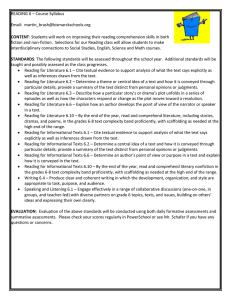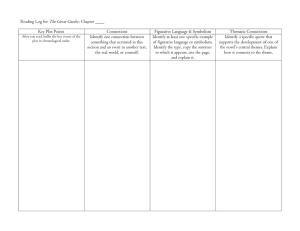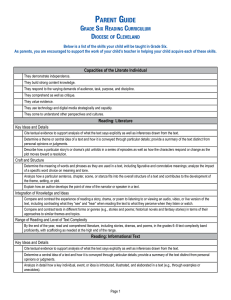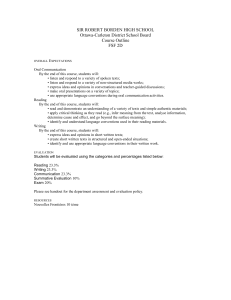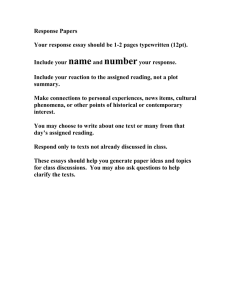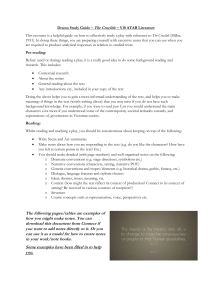North Clackamas` 6th Grade LA Common Core Priority Standards
advertisement
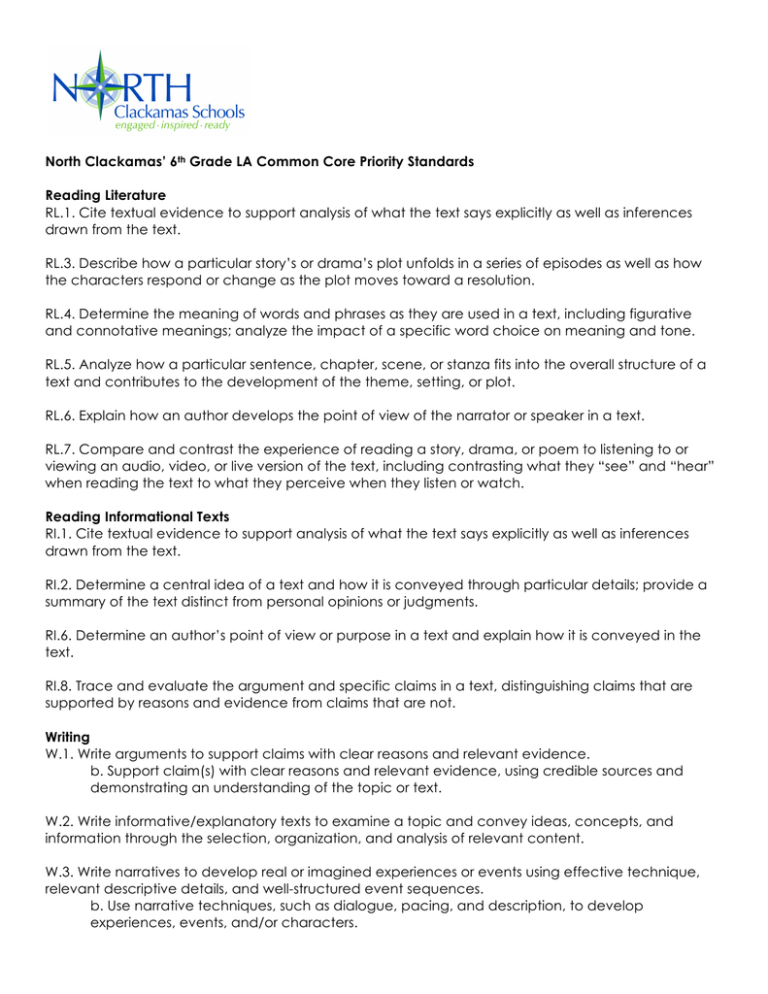
North Clackamas’ 6th Grade LA Common Core Priority Standards Reading Literature RL.1. Cite textual evidence to support analysis of what the text says explicitly as well as inferences drawn from the text. RL.3. Describe how a particular story’s or drama’s plot unfolds in a series of episodes as well as how the characters respond or change as the plot moves toward a resolution. RL.4. Determine the meaning of words and phrases as they are used in a text, including figurative and connotative meanings; analyze the impact of a specific word choice on meaning and tone. RL.5. Analyze how a particular sentence, chapter, scene, or stanza fits into the overall structure of a text and contributes to the development of the theme, setting, or plot. RL.6. Explain how an author develops the point of view of the narrator or speaker in a text. RL.7. Compare and contrast the experience of reading a story, drama, or poem to listening to or viewing an audio, video, or live version of the text, including contrasting what they “see” and “hear” when reading the text to what they perceive when they listen or watch. Reading Informational Texts RI.1. Cite textual evidence to support analysis of what the text says explicitly as well as inferences drawn from the text. RI.2. Determine a central idea of a text and how it is conveyed through particular details; provide a summary of the text distinct from personal opinions or judgments. RI.6. Determine an author’s point of view or purpose in a text and explain how it is conveyed in the text. RI.8. Trace and evaluate the argument and specific claims in a text, distinguishing claims that are supported by reasons and evidence from claims that are not. Writing W.1. Write arguments to support claims with clear reasons and relevant evidence. b. Support claim(s) with clear reasons and relevant evidence, using credible sources and demonstrating an understanding of the topic or text. W.2. Write informative/explanatory texts to examine a topic and convey ideas, concepts, and information through the selection, organization, and analysis of relevant content. W.3. Write narratives to develop real or imagined experiences or events using effective technique, relevant descriptive details, and well-structured event sequences. b. Use narrative techniques, such as dialogue, pacing, and description, to develop experiences, events, and/or characters. W.5. With some guidance and support from peers and adults, develop and strengthen writing as needed by planning, revising, editing, rewriting, or trying a new approach. (Editing for conventions should demonstrate command of Language standards 1–3 up to and including grade 6 on page 52.) W.10. Write routinely over extended time frames (time for research, reflection, and revision) and shorter time frames (a single sitting or a day or two) for a range of discipline-specific tasks, purposes, and audiences. Speaking and Listening SL.1. Engage effectively in a range of collaborative discussions (one-on-one, in groups, and teacher led) with diverse partners on grade 6 topics, texts, and issues, building on others’ ideas and expressing their own clearly. b. Follow rules for collegial discussions, set specific goals and deadlines, and define individual roles as needed. d. Review the key ideas expressed and demonstrate understanding of multiple perspectives through reflection and paraphrasing. SL.5. Include multimedia components (e.g., graphics, images, music, sound) and visual displays in presentations to clarify information. Language L.1. Demonstrate command of the conventions of standard English grammar and usage when writing or speaking. a. Ensure that pronouns are in the proper case (subjective, objective, possessive). L.2. Demonstrate command of the conventions of standard English capitalization, punctuation, and spelling when writing. a. Use punctuation (commas, parentheses, dashes) to set off nonrestrictive/parenthetical elements.* L.4. Determine or clarify the meaning of unknown and multiple-meaning words and phrases based on grade 6 reading and content, choosing flexibly from a range of strategies. a. Use context (e.g., the overall meaning of a sentence or paragraph; a word’s position or function in a sentence) as a clue to the meaning of a word or phrase. L.5. Demonstrate understanding of figurative language, word relationships, and nuances in word meanings. a. Interpret figures of speech (e.g., personification) in context.
